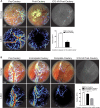Intraoperative Laser Speckle Contrast Imaging For Real-Time Visualization of Cerebral Blood Flow in Cerebrovascular Surgery: Results From Pre-Clinical Studies
- PMID: 32376983
- PMCID: PMC7203106
- DOI: 10.1038/s41598-020-64492-5
Intraoperative Laser Speckle Contrast Imaging For Real-Time Visualization of Cerebral Blood Flow in Cerebrovascular Surgery: Results From Pre-Clinical Studies
Abstract
Cerebrovascular surgery can benefit from an intraoperative system that conducts continuous monitoring of cerebral blood flow (CBF). Such a system must be handy, non-invasive, and directly integrated into the surgical workflow. None of the currently available techniques, considered alone, meets all these criteria. Here, we introduce the SurgeON™ system: a newly developed non-invasive modular tool which transmits high-resolution Laser Speckle Contrast Imaging (LSCI) directly onto the eyepiece of the surgical microscope. In preclinical rodent and rabbit models, we show that this system enabled the detection of acute perfusion changes as well as the recording of temporal response patterns and degrees of flow changes in various microvascular settings, such as middle cerebral artery occlusion, femoral artery clipping, and complete or incomplete cortical vessel cautery. During these procedures, a real-time visualization of vasculature and CBF was available in high spatial resolution through the eyepiece as a direct overlay on the live morphological view of the surgical field. Upon comparison with indocyanine green angiography videoangiography (ICG-VA) imaging, also operable via SurgeON, we found that direct-LSCI can produce greater information than ICG-VA and that continuous display of data is advantageous for performing immediate LSCI-guided adjustments in real time.
Conflict of interest statement
Authors A.R., J.C., K.R., S.I.C. and M.J.B. were employed by Vasoptic Medical, Inc. when the research was carried out. A.R., K.R., M.J.B have ownership interests in Vasoptic Medical, Inc. One or more patents pertaining to the system and methods described in this manuscript are assigned to Vasoptic Medical, Inc. and list A.R. and M.J.B. as inventors.
Figures






Similar articles
-
Continuous blood flow visualization with laser speckle contrast imaging during neurovascular surgery.Neurophotonics. 2022 Apr;9(2):021908. doi: 10.1117/1.NPh.9.2.021908. Epub 2022 Mar 7. Neurophotonics. 2022. PMID: 35265733 Free PMC article.
-
Comparison of indocyanine green angiography and laser speckle contrast imaging for the assessment of vasculature perfusion.Neurosurgery. 2012 Nov;71(5):1023-30; discussion 1030-1. doi: 10.1227/NEU.0b013e31826adf88. Neurosurgery. 2012. PMID: 22843129 Free PMC article.
-
A Novel Intraoperative Laser Light Imaging System to Simultaneously Visualize Visible Light and Near-Infrared Fluorescence for Indocyanine Green Videoangiography.Cerebrovasc Dis Extra. 2018;8(2):96-100. doi: 10.1159/000490872. Epub 2018 Jul 27. Cerebrovasc Dis Extra. 2018. PMID: 30056450 Free PMC article.
-
Intraoperative cerebral blood flow monitoring in neurosurgery: A review of contemporary technologies and emerging perspectives.Neurochirurgie. 2022 Jul;68(4):414-425. doi: 10.1016/j.neuchi.2021.10.005. Epub 2021 Dec 10. Neurochirurgie. 2022. PMID: 34895896 Review.
-
Essentials in intraoperative indocyanine green videoangiography assessment for intracranial aneurysm surgery: conclusions from 295 consecutively clipped aneurysms and review of the literature.Neurosurg Focus. 2014 Feb;36(2):E7. doi: 10.3171/2013.11.FOCUS13475. Neurosurg Focus. 2014. PMID: 24484260 Review.
Cited by
-
SpeckleCam: high-resolution computational speckle contrast tomography for deep blood flow imaging.Biomed Opt Express. 2023 Sep 20;14(10):5316-5337. doi: 10.1364/BOE.498900. eCollection 2023 Oct 1. Biomed Opt Express. 2023. PMID: 37854569 Free PMC article.
-
Comparison of ketamine/xylazine and isoflurane anesthesia on the establishment of mouse middle cerebral artery occlusion model.Exp Anim. 2023 May 17;72(2):209-217. doi: 10.1538/expanim.22-0131. Epub 2022 Nov 23. Exp Anim. 2023. PMID: 36418078 Free PMC article.
-
Continuous blood flow visualization with laser speckle contrast imaging during neurovascular surgery.Neurophotonics. 2022 Apr;9(2):021908. doi: 10.1117/1.NPh.9.2.021908. Epub 2022 Mar 7. Neurophotonics. 2022. PMID: 35265733 Free PMC article.
-
High spatiotemporal mapping of cortical blood flow velocity with an enhanced accuracy.Biomed Opt Express. 2024 Mar 15;15(4):2419-2432. doi: 10.1364/BOE.520886. eCollection 2024 Apr 1. Biomed Opt Express. 2024. PMID: 38633086 Free PMC article.
-
Using Laser Speckle Contrast Imaging to Quantify Perfusion Quality in Kidney and Pancreas Grafts on Vascular Reperfusion: A Proof-of-Principle Study.Transplant Direct. 2023 Apr 19;9(5):e1472. doi: 10.1097/TXD.0000000000001472. eCollection 2023 May. Transplant Direct. 2023. PMID: 37090123 Free PMC article.
References
-
- Zaidi, H. A. et al. Indocyanine green angiography in the surgical management of cerebral arteriovenous malformations: lessons learned in 130 consecutive cases. Neurosurgery10 Suppl 2, 246–251; discussion 251, 10.1227/neu.0000000000000318 (2014). - PubMed
-
- Dashti, R., Laakso, A., Niemela, M., Porras, M. & Hernesniemi, J. Microscope-integrated near-infrared indocyanine green videoangiography during surgery of intracranial aneurysms: the Helsinki experience. Surgical neurology71, 543–550; discussion 550, 10.1016/j.surneu.2009.01.027 (2009). - PubMed
Publication types
MeSH terms
Grants and funding
LinkOut - more resources
Full Text Sources

